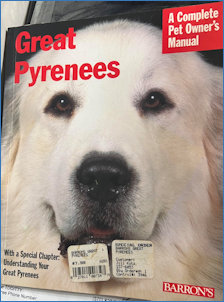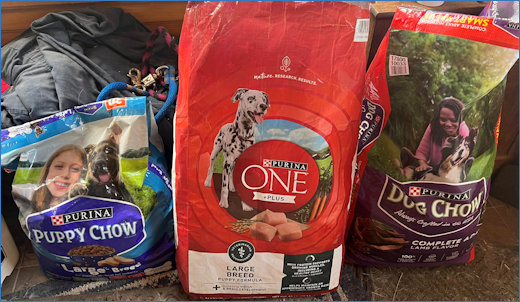|
|
Our Great Pyrenees
FAQ's
(pdf document)
| Food & Nutrition Requirements: |
| The brand of dog food we recommend is Purina. Blue
bag at Tractor Supply is called Purina PUPPY CHOW Large
Breed. Next, we use Red bag Purina ONE Plus Large Breed
Puppy Formula. Please note that this dog food is hard &
soft and it can cause the puppy to choke so watch your
puppy for the first 7-10 days as they transition to this
puppy food. Once they are full sized we use Red bag
Purina DOG CHOW. All three dog foods can be purchased at
a Tractor Supply store. We recommend feeding three times
per day at 7 am, 4 pm and 9 pm with pupples and they get
16 ounces per feeding. Our Baier & Beauty gained on
average 18 pounds per month, so feeding the puppy
properly is critical to their growth! When they hit
their adult weight they will back off to 8 ounces
traditionally twice a day like a black lab. Baier is our
male and he weighs 120 pounds as an adult. Our females
all average around 75-95 pounds. |
| Kennel/Dog Cage: |
| We train all our Dogs to be crated for their safety
if needed. We buy the kennels from Tractor Supply and
they are the Extra Large wire crate for the puppies when
they are young so they understand the cage concept. It's
safer to transport puppies in vehicles when we deliver
them as well. They like an open crate to see out if not
the hard sided crates which can cause them to feel
claustrophobic. |
| Toys: |
| Toys for a Great Pyrenees are the Benefel hard chew
toys & rope toys. They seem to help with teething and
last a long time to help the dogs with any boredom. |
| Dog collars: |
| We recommend the Halo Advanced GPS technology. |
| Fencing: |
| We use Premier hot netting with our sheep & goats
which the dogs can feel the electricity in them. |
| Recommended reading: |
| We recommend a book called Great Pyrenees. A
Complete pet owners manual and is available on
Amazon. It has a special chapter on understanding your
Great Pyrenees. It's a great read on the breed & things
to always consider! |
| Wormers: |
| Sentry HC WormXDS liquid dog wormer for dogs
available at Tractor Supply. It removes large roundworms
and hookworms in pupplies and dogs. Treats up to 120
pounds. |
Our Recommended Products:
 |
 |
 |
 |
| Great reading! |
Dog Food |
Wormer |
Kennels |
Great Pyrenees Faq's....
1) Great Pyrenees at a Glance:
Pyrs are a large breed, with males growing up to 32
inches and generally weighing 100 pounds or more. They have floppy
ears and a white coat, which can come with markings of gray, tan or
brown. This coat forms a thick ruff of mane around the neck and
shoulders, which was useful while guarding sheep as it stopped
wolves being able to get a good grip on their necks. The ruff is
more pronounced on males of the breed.
2) History of the Breed:
Pyrs are an ancient breed, and their remains have
been found in fossil deposits from the Bronze Age. They worked with
shepherds in the Pyrenees Mountains between Spain and France,
protecting livestock from attack. Their elegance and character meant
they could not remain in the mountains and by 1675 they had been
named the Royal Dog of France. This increased the demand for the
dogs, and many members of the French nobility owned one. However,
they mostly remained a working dog and can still be found guarding
sheep today.
3) Great Pyrenees
Personality:
Pyrs were often left alone in mountain valleys with
just their flock for company, so have developed a strong,
independent streak. This has not made them aloof, though. They are
generally known as calm, well-mannered, and devoted to their family.
The Pyrenees have an affectionate nature and their time spent as
guardians have made them gentle with children and small animals.
They try to protect their family if the need arises, and many remain
wary of strangers, especially if they sense their owners are
uncomfortable.
Please check out the following .pdf info pages
Dog Licensing Info
PA Dog Laws
|